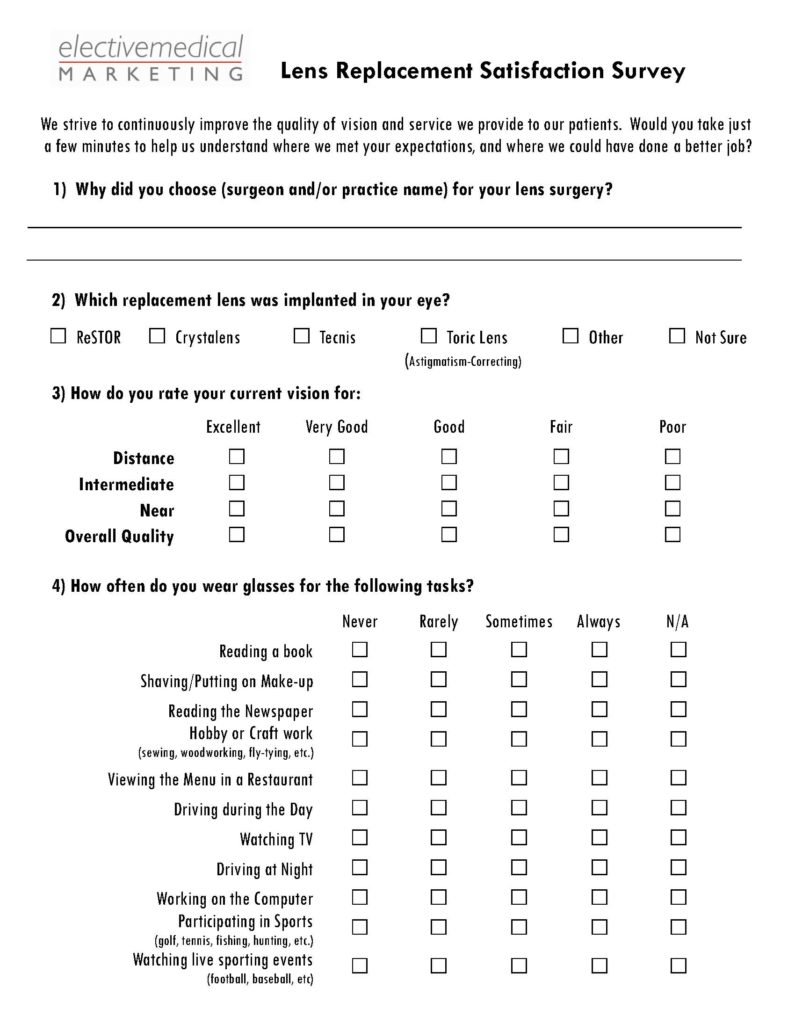
 Staying on top of Lifestyle IOL performance has been difficult. It seems we are so busy adjusting appointment schedules, refining patient education, modifying staffing and monitoring outcomes that until recently, we completely forgot to ask our patients – in an unbiased, detailed manner – how they think they’re doing!
Staying on top of Lifestyle IOL performance has been difficult. It seems we are so busy adjusting appointment schedules, refining patient education, modifying staffing and monitoring outcomes that until recently, we completely forgot to ask our patients – in an unbiased, detailed manner – how they think they’re doing!
If you’ve been implanting elective lenses for over a year, you should now have a substantial pool of post-op patients with ReSTOR, Tecnis, Crystalens® and Toric lenses who have lived with their vision long enough that they can give you a true assessment of their results. Now is the perfect opportunity, to check in with these patients and see how THEY feel about their vision. It can be quite different from how YOU thought they were doing!
 We recently fielded a Lens Satisfaction Survey to all patients within our practices that had cataract surgery in the prior two years. We wanted to hear what they had to say about their vision at various distances, their perception of vision quality, their satisfaction with lens choice, what we did well and most importantly what we could improve upon by provider and by visit type.
We recently fielded a Lens Satisfaction Survey to all patients within our practices that had cataract surgery in the prior two years. We wanted to hear what they had to say about their vision at various distances, their perception of vision quality, their satisfaction with lens choice, what we did well and most importantly what we could improve upon by provider and by visit type.
We fielded the survey by mail, sending it with a stamped, self-addressed envelope for easy return. It would have been easier to send via email including a response link to one of the great online survey tools (like Survey Monkey), but we didn’t have email addresses for the majority of our cataract patients. Instead, a paper copy was mailed, returned and entered by the surgical counselors into Zoomerang, so we have professionally compiled data and quick access to analyze and chart results by lens type, patient demographic or practice.
Our most important finding was how often patients say they wear glasses for various near, intermediate and distance activities. This allowed us to create a practice outcomes chart that clearly sets expectations for glasses-wear between monofocal and multifocal patients. The survey
results also helped us refine how we talk to patients about post-surgery vision. They can more easily see, with our new comparison pie charts, that Lifestyle IOLs deliver reduced glasses-wear vs. monofocal lenses, but they will still need glasses for some tasks or at certain times.
Don’t be afraid that glasses-wear results will scare candidates away. Instead, you’ll be setting more reasonable expectations that will ultimately leave patients more satisfied.
Another important finding was how we treat patients. We uncovered comments about wait time, the surgery center environment, patient perceptions about how our staff or surgeon listen, and where we surprised them in unexpected ways that made them feel safe, cared for and happy.
Pay attention to comments that surface repeatedly about what patients heard or felt, even if you think they can’t be true. One comment might just reflect a hard-to-please patient. Several comments about a similar topic mean trouble that is reducing satisfaction and conversion. Remain open-minded to what your patients have to say.
Our Lens Satisfaction results will help us refine marketing, improve in-office messaging, and fine-tune vision outcomes. For about $300 per practice and a bit of staff time, we’ve advanced our delivery of Lifestyle IOL satisfaction immeasurably. You can do the same.